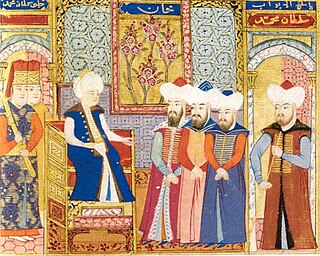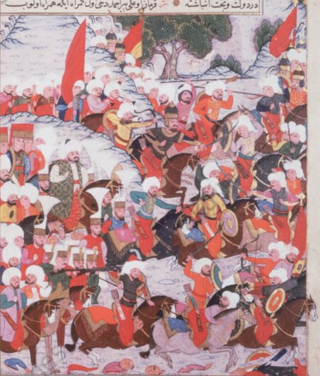
Mehmed I, also known as Mehmed Çelebi or Kirişçi, was the sultan of the Ottoman Empire from 1413 to 1421. Son of Sultan Bayezid I and his concubine Devlet Hatun, he fought with his brothers over control of the Ottoman realm in the Ottoman Interregnum (1402–1413). Starting from the province of Rûm he managed to bring first Anatolia and then the European territories (Rumelia) under his control, reuniting the Ottoman state by 1413, and ruling it until his death in 1421. Called "The Restorer," he reestablished central authority in Anatolia, and he expanded the Ottoman presence in Europe by the conquest of Wallachia in 1415. Venice destroyed his fleet off Gallipoli in 1416 as the Ottomans lost a naval war.

The Karamanids, also known as the Emirate of Karaman and Beylik of Karaman, was an Anatolian beylik of Salur tribe origin, centered in South-Central Anatolia around the present-day Karaman Province. From the mid 14th century until its fall in 1487, the Karamanid dynasty was one of the most powerful beyliks in Anatolia.

The Germiyanids were a prominent Anatolian beylik established by the Oghuz Turkish tribes after the decline of the Sultanate of Rûm. While the beylik was always mentioned as being ethnically Turkoman or Oghuz Turkish, the population consisted of Turks and Yezidi Kurds, brought by the Seljuks from the east of Malatya to western Anatolia as militia guards against the threatening Turkish tribesmen.
The Ramadanid Emirate was an autonomous administration and a de facto independent emirate that existed from 1352 to 1608 in Cilicia, taking over the rule of the region from the Armenian Kingdom of Cilicia. The emirate was a protectorate of the Mamluk Sultanate until the end of the 14th century, then it was de facto independent for more than a century, and then, from 1517, a protectorate of the Ottoman Empire. The capital was Adana.

Alaiye (علائیه) is the medieval Seljuq name for Alanya. It refers to the city-state in a specific period and the beylik which developed around there, at times under the Karamanid dynasty. After the 1242 Battle of Köse Dağ, the Seljuqs lost control of the city, and it became semi-autonomous.

The Eretnids were a dynasty that ruled a state spanning central and eastern Anatolia from 1335 to 1381. The dynasty's founder, Eretna, was an Ilkhanid officer of Uyghur origin, under Timurtash, who was appointed as the governor of Anatolia. Some time after the latter's downfall, Eretna became the governor under the suzerainty of the Jalayirid ruler Hasan Buzurg. After an unexpected victory at the Battle of Karanbük, against Mongol warlords competing to restore the Ilkhanate, Eretna claimed independence declaring himself the sultan of his domains. His reign was largely prosperous earning him the nickname Köse Peyghamber.
Jimri was a pretender to the Sultanate of Rum, promoted by the Turkmen in the chaos after Baibars’ invasion of Mongol-dominated Anatolia in 1277. He was executed the following year. The pretender’s formal name, ‘Ala al-Din Siyavush, appears on his few coins, but the sources almost invariably refer to him by the derogatory nickname Jimri, or “the Miser”.

The Battle of Otlukbeli or Otluk Beli was fought between Aq Qoyunlu and the Ottoman Empire on August 11, 1473.

The Ottoman-Mamluk war took place from 1485 to 1491, when the Ottoman Empire invaded the Mamluk Sultanate territories of Anatolia and Syria. This war was an essential event in the Ottoman struggle for the domination of the Middle-East. After multiple encounters, the war ended in a stalemate and a peace treaty was signed in 1491, restoring the status quo ante bellum. It lasted until the Ottomans and the Mamluks again went to war in 1516–17; in that war the Ottomans defeated and conquered the Mamluks.
Koca Davud Pasha was an Ottoman Albanian general and grand vizier of the Ottoman Empire from 1482 to 1497 during the reign of Bayezid II. He became a damat ("bridegroom") to the Ottoman dynasty by marrying an Ottoman princess, a daughter of Bayezid II whose name is unknown. They had a son, Sultanzade Mehmed Bey, who married his cousin Fatma Sultan, daughter of Şehzade Ahmed.
Ibrahim II was a bey of Karaman.

Nasiraeddin Mehmed II of Karaman, also Mehmed Beg, Mehmed Beg II or Nasir al-Din Mehmed Beg was the Bey ruler of Karaman. His mother was Nefise Hatun, a daughter of Ottoman Sultan Murad I.
Alaeddin Ali II of Karaman was the bey of Karamanids in what is now modern Turkey in the 15th century. He was the second son of Alaattin Ali of Karaman and Nefise Melek Sultan Hatun, Ottoman Sultan Murad I's daughter.
Yakub II, also known as Yakub Chelebi, was Bey of Germiyan in western Anatolia from 1387 to 1390, 1402 to 1411, and 1414 until his death. Yakub was the patron of several literary and architectural works produced during his reign.
Pir Ahmed of Karaman was a bey of Karaman Beylik, a Sunni Muslim Turkoman principality in Anatolia in the 15th century. He was son of Ibrahim II of Karaman and Ilaldi Sultan Hatun, daughter of Ottoman Sultan Mehmed I, and had a daughter, Hilmiye Hatun.

Ala al-Dawla Bozkurt Beg was the ruler of Dulkadir from late 1480 until his death. Championed by the Ottoman Sultan Mehmed II, Bozkurt ousted his brother Shah Budak and claimed the throne. Early into his reign, Bozkurt assisted Mehmed's successor Bayezid II in pursuing his claimant brother Cem Sultan, who was harbored by the Mamluk Sultanate. In response, Bozkurt besieged Malatya, which prompted the Mamluks to initiate an offensive against him and the Ottomans. During the conflict, Bozkurt steered away from sending his support to the Ottomans, which contributed to their defeat by the Mamluks.
Shah Budak was Beg of Dulkadir from October 1465 to April 1466 and 4 June 1472 to 1480. During the reign of his brother, Malik Arslan, Shah Budak took refuge in Mamluk Egypt. He took advantage of the discord between Malik Arslan and the Mamluks by provoking the Mamluk sultan to commission his brother's assassination. Malik Arslan was killed in October 1465, and Shah Budak rose to the throne afterwards. However, before the Mamluk forces could come to his aid, he was defeated by his other brother, Shah Suwar, who was backed by the Ottoman Sultan Mehmed II. Shah Suwar was engaged in continuous warfare against the Mamluk Sultanate, whereas Shah Budak took sides with the latter. Shah Suwar was caught by the Mamluk forces on 4 June 1472.
Sayf al-Din Malik Arslan was Beg of Dulkadir from 28 August 1454 until his death. Malik Arslan was one of his predecessor Suleiman Beg's numerous sons. Malik Arslan first competed with his uncle Feyyaz for the throne and was favored by the Mamluk Sultan Sayf al-Din Inal. Later into his reign, Malik Arslan was involved in the succession wars within the Karamanids. He ransacked the region wishing to retake Kayseri but was crushed by the Aq Qoyunlu ruler Uzun Hasan. In September 1465, Malik Arslan ceded Harpoot to Uzun Hasan, who had taken advantage of the worsening relations between Malik Arslan and the Mamluks. Malik Arslan was assassinated on the orders of Khushqadam incited by Malik Arslan's rival brother Shah Budak, who replaced him.

Shah Suwar was the ruler of Dulkadir from April 1466 to 4 June 1472. Upon the assassination of his brother, Malik Arslan, he competed for the throne against his other brother Shah Budak, who took over with the support of the Mamluk Sultanate. Shah Suwar was welcomed by the Ottoman Sultan Mehmed II, who appointed him to a number of positions in his realm. Six months into Shah Budak's reign, Shah Suwar defeated him and instead became the new ruler in April 1466. The Mamluks fiercely disputed Shah Suwar's reign. The Sultans Khushqadam and Qaitbay launched multiple consecutive campaigns to subdue him. Shah Suwar initially triumphed over the Mamluks and expanded his territory, occupying the entirety of the Ramadanid realm.
Sarim al-Din Ibrahim I was Beg of Ramadan by June 1354 to 1383. Following his father Ramadan's death, Ibrahim arrived in Damascus and honored the Mamluk Sultan, securing the regional authority the Mamluks had granted Ramadan. Soon after, Ibrahim allied himself with Ghars al-Din Khalil, the ruler of the Dulkadirids, in an attempt to seize Sis. The Mamluk governor of Aleppo was assigned to deal with Ibrahim but was defeated by other local lords. The Mamluks recognized Ibrahim's authority in 1381 and granted him the title na'ib (viceroy) of Adana two years later. Ibrahim made a new attempt to realize his ambition to capture Sis. This restored the state of war between the Ramadanids and the Mamluk Sultanate. After fleeing from the Mamluks for some time, Ibrahim was caught by the Mamluk na'ib of Sis. Ibrahim was executed in the town of Sis. He was succeeded by his brother Ahmed.









